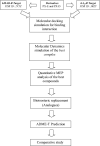Molecular docking/dynamics simulations, MEP analysis, bioisosteric replacement and ADME/T prediction for identification of dual targets inhibitors of Parkinson's disease with novel scaffold
- PMID: 36687301
- PMCID: PMC9852416
- DOI: 10.1007/s40203-023-00139-3
Molecular docking/dynamics simulations, MEP analysis, bioisosteric replacement and ADME/T prediction for identification of dual targets inhibitors of Parkinson's disease with novel scaffold
Abstract
Monoamine oxidase B and Adenosine A2A receptors are used as key targets for Parkinson's disease. Recently, hMAO-B and hA2AR Dual-targets inhibitory potential of a novel series of Phenylxanthine derivatives has been established in experimental findings. Hence, the current study examines the interactions between 38 compounds of this series with hMAO-B and hA2AR targets using different molecular modeling techniques to investigate the binding mode and stability of the formed complexes. A molecular docking study revealed that the compounds L24 ((E)-3-(3-Chlorophenyl)-N-(4-(1,3-dimethyl-2,6-dioxo-2,3,6,7-tetrahydro-1H-purin-8-yl) phenyl) acrylamide and L32 ((E)-3-(3-Chlorophenyl)-N-(3-(1,3-dimethyl-2,6-dioxo-2,3,6,7-tetrahydro-1H-purin-8-yl)phenyl)acrylamide) had a high affinity (S-score: -10.160 and -7.344 kcal/mol) with the pocket of hMAO-B and hA2AR targets respectively, and the stability of the studied complexes was confirmed during MD simulations. Also, the MEP maps of compounds 24 and 32 were used to identify the nucleophilic and electrophilic attack regions. Moreover, the bioisosteric replacement approach was successfully applied to design two new analogs of each compound with similar biological activities and low energy scores. Furthermore, ADME-T and Drug-likeness results revealed the promising pharmacokinetic properties and oral bioavailability of these compounds. Thus, compounds L24, L32, and their analogs can undergo further analysis and optimization in order to design new lead compounds with higher efficacy toward Parkinson's disease.
Supplementary information: The online version contains supplementary material available at 10.1007/s40203-023-00139-3.
Keywords: ADME-T; Bioisosteric replacement; MEP maps; Molecular docking/dynamics; Parkinson’s disease; Phenylxanthine derivatives.
© The Author(s), under exclusive licence to Springer-Verlag GmbH Germany, part of Springer Nature 2023, Springer Nature or its licensor (e.g. a society or other partner) holds exclusive rights to this article under a publishing agreement with the author(s) or other rightsholder(s); author self-archiving of the accepted manuscript version of this article is solely governed by the terms of such publishing agreement and applicable law.
Conflict of interest statement
Conflict of interestThe authors declare no potential conflicts of interest with respect to the research, authorship, and/or publication of this article.
Figures









Similar articles
-
Discovery of novel and potent safinamide-based derivatives as highly selective hMAO-B inhibitors for treatment of Parkinson's disease (PD): Design, synthesis, in vitro, in vivo and in silico biological studies.Bioorg Chem. 2021 Oct;115:105233. doi: 10.1016/j.bioorg.2021.105233. Epub 2021 Aug 2. Bioorg Chem. 2021. PMID: 34390968
-
Discovery of 3,4-dichloro-N-(1H-indol-5-yl)benzamide: A highly potent, selective, and competitive hMAO-B inhibitor with high BBB permeability profile and neuroprotective action.Bioorg Chem. 2021 Nov;116:105352. doi: 10.1016/j.bioorg.2021.105352. Epub 2021 Sep 11. Bioorg Chem. 2021. PMID: 34562673
-
Design, Synthesis, Molecular Docking, Pharmacokinetic Properties, and Molecular Dynamics Simulation of Sulfonyl Derivatives of Benzimidazole against Parkinson's Disease.Curr Med Chem. 2024 Oct 24. doi: 10.2174/0109298673337912241007120510. Online ahead of print. Curr Med Chem. 2024. PMID: 39449335
-
Computational Studies Applied to Linalool and Citronellal Derivatives Against Alzheimer's and Parkinson's Disorders: A Review with Experimental Approach.Curr Neuropharmacol. 2023;21(4):842-866. doi: 10.2174/1570159X21666230221123059. Curr Neuropharmacol. 2023. PMID: 36809939 Free PMC article. Review.
-
Caffeine as a lead compound for the design of therapeutic agents for the treatment of Parkinson's disease.Curr Med Chem. 2015;22(8):975-88. doi: 10.2174/0929867322666141215160015. Curr Med Chem. 2015. PMID: 25544641 Review.
Cited by
-
In silico bioprospecting of receptors for Doderlin: an antimicrobial peptide isolated from Lactobacillus acidophilus.In Silico Pharmacol. 2023 Apr 25;11(1):11. doi: 10.1007/s40203-023-00149-1. eCollection 2023. In Silico Pharmacol. 2023. PMID: 37113323 Free PMC article.
-
Advance Screening of Bis-azetidinone Derivatives: Synthesis, Spectroscopy, Antioxidant and Antimicrobial Analysis with Molecular Docking Assessment.Curr Org Synth. 2025;22(3):396-409. doi: 10.2174/0115701794318870240923073910. Curr Org Synth. 2025. PMID: 40259592
-
A combined in vitro, in vivo and in silico approach for the discovery of bioactive molecules from Corchorus olitorius L as pancreatic lipase inhibitors, interleukin-6 and tumor necrosis factor alpha TNF-α.J Mol Histol. 2025 Jul 15;56(4):229. doi: 10.1007/s10735-025-10514-3. J Mol Histol. 2025. PMID: 40663253
References
-
- Azam F, Abodabos HS, Taban IM, Rfieda AR, Mahmood D, Anwar MJ, Khan S, Sizochenko N, Poli G, Tuccinardi T, Ali HI. Rutin as promising drug for the treatment of Parkinson’s disease: an assessment of MAO-B inhibitory potential by docking, molecular dynamics and DFT studies. Mol Simul. 2019;45(18):1563–1571. doi: 10.1080/08927022.2019.1662003. - DOI
LinkOut - more resources
Full Text Sources

